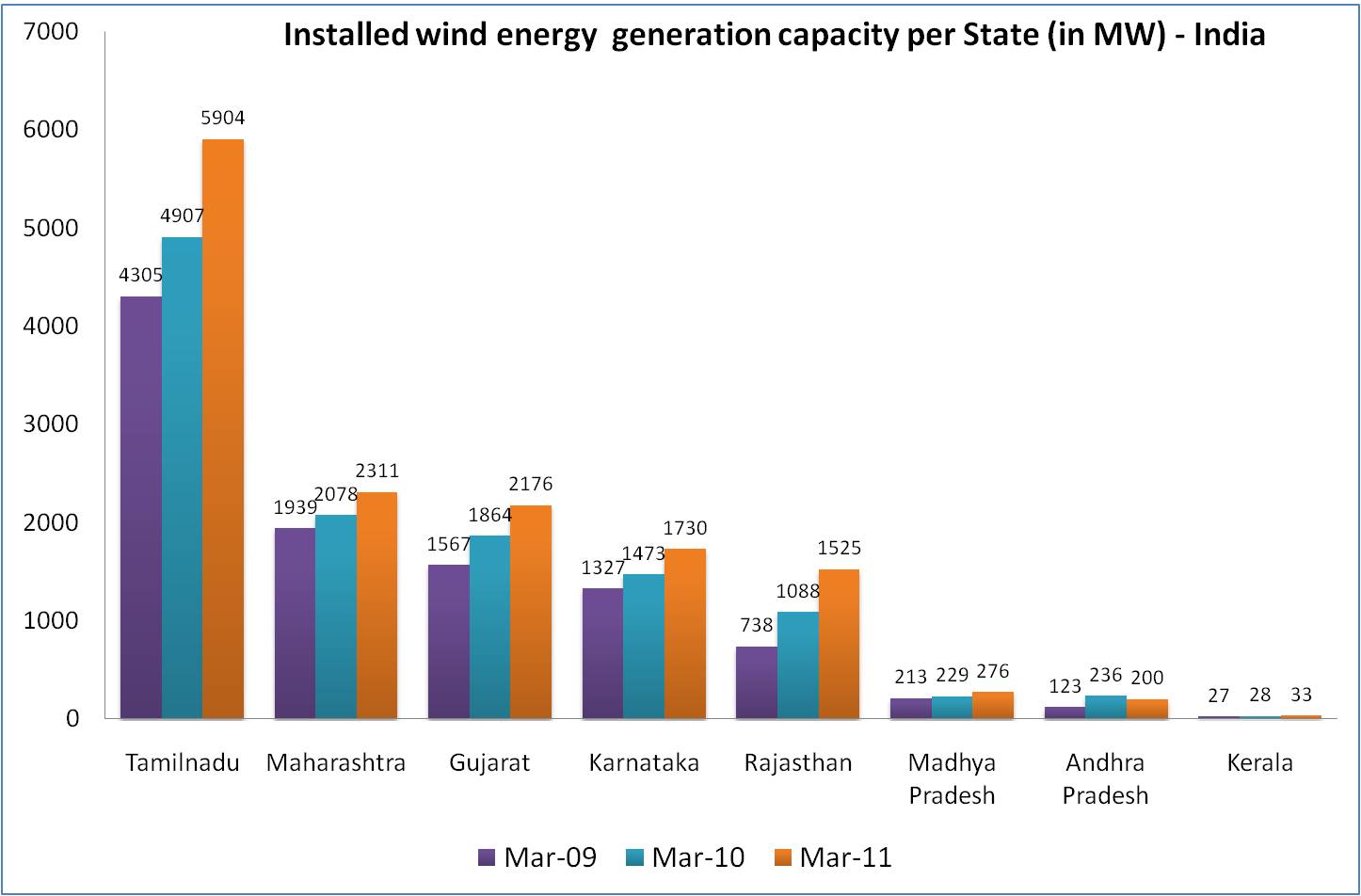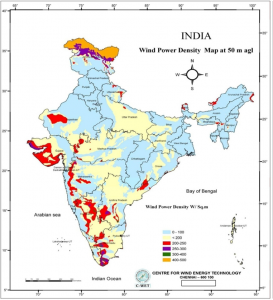Power deficit – The answer is blowing in the wind
The Economic Times (Jun 10, 2011): “Renewable energy can help bridge energy deficit, check govt’s subsidy burden: Switching rural India on to renewable energy sources could help the country bridge its widening energy deficit, according to the Planning Commission. The panel has suggested diversification of the rural energy basket as a measure to deal with the shortage of fuel at thermal power stations and to check the government’s rising subsidy burden”.
Wind energy has emerged into a mature and booming global business world wide in spite of high cost involvement in the project and low plant load factors. Thanks to the improved technologies in the sector and widened knowledge about the climatic patterns to assess wind speed of the region. From last few years generation costs have also fallen over per mega watt of power generation and it is moving competitive with other renewable energy sources.
According to the GWEC, by 2008, over €36.5 billion were invested in wind energy worldwide and the annual value of global investment in wind energy would reach €149.4 bn by 2020. Over the last decade, global wind installations have continued to grow at an average growth rate of around 30%.
Indian Wind Energy program was initiated towards the end of the Sixth Plan, in 1983-84 and became considerably successful among private investors/developers in setting up of commercial wind power projects. As per the estimate of C-WET, the gross potential for the wind energy in India is around 48,561 MW and a total of about 14,158 MW of commercial projects have been established up to March 31, 2011. It means wind power accounts for 6 percent of India’s total installed power capacity and generates 1.6% (actual power generation based on specific Plant Load Factors) of the country’s power.
Indian wind energy scenario: Installed Wind Capacity per state (in MW)

Overview of wind energy;

What is exactly wind energy?
Air in motion is wind. Since air has mass and when you have mass in motion, it has momentum which is nothing but energy and can be utilized.
Power generated (Wind) = ½ X Air Density X Projected Area X (Average wind speed) 3
As seen in the formula, the greater the wind speed, higher will be the power as it increases with the cube of wind speed. The simple conversion that takes place in a wind turbine is from kinetic to mechanical energy which can further converted into electrical energy using energy generator.
Therefore wind resource assessment plays an important role in wind energy sector as it provide back up for the techno-commercial analysis for the selection of land and the subsequent establishment of Wind farms. The wind resource assessment programme is being implemented in the country through the centre for wind energy technology (C‐WET). C-WET is an autonomous institution of the Ministry of new and renewable energy and associated state nodal agencies. Following map shows ‘Wind Power Density’ of different locations in India.
Type of wind turbines

Vertical axis wind turbines and horizontal axis wind turbines (more growth and used commonly) are the two variants of wind turbines. The power that will be produced by a wind turbine system will depend on the turbine size and the wind speed. At some places even wind turbines of capacity 6MW are in operation; in India 225kW to 2.5 MW are working (KENERSYS India launched the K100 2.5 MW in 2011). Turbines in the range of 5 MW are under development and research. Small turbines for stand alone or domestic applications in range of 300W to 25 kW are also now available. Some other factors affecting wind power generation is the turbine height and elevation, at good elevation, more wind speed will be available and less obstruction and friction is experienced. Drier air produces more power than humid air. Usually, a wind turbine system lasts for 20 years.
Type of wind farms
- On shore: The wind farms which is about three kilometres away from the nearest shore line.
- Near Shore: The wind farm lies on land within three kilometres from the nearest shore line or lying in water within ten kilometres from the shore.
- Off shore: The wind farms which is more than ten kilometres into the sea from the shore.
- Airborne: It is a new concept which is under development. Such wind turbines suspended high in the atmosphere thereby it can obtain fastest and strongest wind available. It is a design concept for a wind turbine that is supported in the air without a tower. (Know more)
Low Plant Load Factors
Wind energy sector mostly depends on efficient low cost technologies and best plant load factors (generation efficiency) as the best available technology can only harness optimum power in the range of 20-45%. Off shore wind farms show greater efficiency as the wind speed is higher on sea/ oceans as compare to the land.
The plant load factor (PLF) of a wind energy generator is the ratio of the actual output of a wind energy generator over a period of time and its potential output if it had operated at full capacity (installed capacity).
In India, few states have good wind speed and hence these regions are techno-commercially suitable for establishment of wind farms. The state of Tamilnadu has highest wind potential and installed capacity in the country followed my Maharashtra, Gujarat, Karnataka, and Rajasthan. Other states have also established wind farms but are in very few numbers.
Following graph shows total power generation (actual) by the top five states of India;

As seen on the figure 4, total wind power generation is very low as compare to the installed power generation capacity (Figure 1).
Indian government supports wind energy sector;
Government of India supports wind energy sector in many ways. Some of them are financial provisions for wind energy generators. Following list provide information on current fiscal and Tax incentives for the wind energy project developers. (Source: Global Wind Energy Council)
- 80% accelerated depreciation for investors if the project is commissioned before 30 September of the same financial year; or 40% if the project is commissioned before 31 March of the same financial year.
- Generation Based Incentive (GBI) scheme for grid interactive wind power projects -a GBI of Rs 0.50 per kWh as introduced in 2009 [details below]
- Concession on import duty on specified wind turbine component
- 10 year income tax holiday for wind power generation project
- 100% exemption from excise duty on certain wind turbine component
- Wheeling, banking and third party sales, buy–back facility by state
- Guaranteed market through a specified renewable portfolio standard in some states, as decided by the state electricity regulator
- Reduced wheeling charges as compared to conventional energy
- 100% FDI investment allowed in renewable energy generation project
- Special incentives provided for promotion of exports from India for various renewable energy technologies under renewable sector specific Special Economic Zones (SEZ)
- Wind potential states have announced preferential tariffs, ranging from Rs 3.39–5.32 per kW
Know more about Importance of wind energy sector in meeting NAPCC renewable energy targets
Know more about National Action Plan on Climate Change (NAPCC)
As per the study conducted by Global wind Energy Council, wind energy would rise to 5% of the world electricity demand by 2030 which is around 1400 terawatt hours (TWh) assuming 2009 references scenario by the International Energy Agency (IEA). India is in the list of top five wind energy producer countries as it ranks 5th in the list after USA, China, Germany and Spain. India has tremendous wind energy potential as compared from what exhausted presently. Indian Wind Energy Association has estimated that with the current level of technology, the ‘on-shore’ potential for utilization of wind energy for electricity generation is of the order of 65,000 MW.
Reference: C-WET, GWEC, IWEA, MNRE
Authors;
Puskar Pande, Shailesh Telang


Thanks for the post, keep us updated!
Hello Sir/Mam,
Hope you are doing great!
Here is Tejas Amale, from Market Research Future.
The reason for writing this letter is that I want to publish an article based on “Wind Power” on your esteemed website. I would be glad if you publish my article on your website. It is related to the latest Technology Trends for business persons.
Would you be interested in publishing this article? or revert me if you have any different perspective, I’d be very happy to write accordingly.
Regards,
Tejas Amale
Sr. SEO Analyst